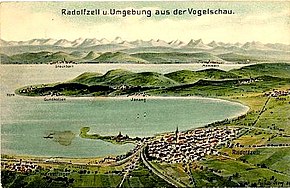Höri (Lake Constance)
| Höri | ||
 View of the Höri peninsula from Radolfzell (around 1900) |
||
| Geographical location | ||
|
|
||
| Coordinates | 47 ° 41 '9 " N , 8 ° 55' 9" E | |
| Waters 1 | Untersee_ (Lake Constance) | |
| Waters 2 | Lake Zell | |
| length | 10 km | |
| width | 10 km | |
| surface | 45 km² | |
The Höri is a peninsula in western Lake Constance between Stein am Rhein and Radolfzell .
geography
The approximately 45 km² large Höri peninsula encompasses the northern bank of the Untersee and the southern bank of the Zeller See with the municipalities of Gaienhofen , Moos and Öhningen , which make up the municipal administration association Höri . The district of Bohlingen , which belongs to Singen (Hohentwiel) , is also counted as part of the Höri and is known as the “Gate to the Höri”.
The highest point is 715.6 m above sea level. NHN the Schiener Berg , the lowest point is the shore of the Untersee at 395.11 m .
origin of the name
Hence the name Hori is derived that it is a formerly to the diocese Konstanz ge Hori is saturated area. He is mentioned for the first time in 1155 in a document from Emperor Barbarossa , in which he confirms various possessions to the Bishop of Constance . In the Middle Ages, Höri was used to designate closed domains. Oberstaad Castle is located at the southernmost point of the peninsula .
In popular parlance, there is an explanation of the origin of the name that the name is derived from a comfortably exhausted saying of God (in Maritime Alemannic dialect ) at the end of the creation of the world - and last but not least the Lake Constance region ("Now hear i uff!" "Now I'm going to stop!").
art
During the time of National Socialism , many well-known artists, who were described by the National Socialists as " degenerate ", moved to the Höri peninsula in order to be able to flee to nearby Switzerland if necessary. In the 1950s, more artists appeared and an artist scene was established. The term "Höri painter" or " Höri artist " arose, whereby the artists were less connected by a common painting style than by the motives for which they chose the Höri peninsula as their domicile. Many well-known artists, including Walter Kaesbach (Director of the Düsseldorf Art Academy ), Max Ackermann , Erich Heckel (co-founder of the artist group Die Brücke ), Otto Dix (member of the artists' association Das Junge Rheinland ), Ferdinand Macketanz , Hans Sauerbruch , Curth Georg Becker , Walter Herzger , Rudolf Stuckert , Rosemarie Stuckert-Schnorrenberg , Jean Paul Schmitz (member of Das Junge Rheinland ) and the publisher Curt Weller found a new home here in the idyllic landscape and near Switzerland. In numerous works (paintings, drawings, watercolors) the shore landscape of the Untersee and the landscape of the adjacent Hegau can be found, as the region offers a welcome and unmistakable motif due to the Mediterranean character in connection with the striking volcanic cones of the Hegau.
The writer Hermann Hesse also lived temporarily on the Höri peninsula. Hermann Hesse and Walter Kaesbach can be named as the driving force of the art scene. Both attracted many other artists and arranged accommodation and studios for the newcomers. The painter and graphic artist Walter Waentig from Zittau acquired Hesse's house in Gaienhofen in 1920 .
Even in the early 21st century, many artists live in the region; numerous studios shape community life in the districts.
See also
Web links
References and comments
- ↑ Rolf Hirt: Höri begins in Bohlingen In: Südkurier , September 7, 2006. Retrieved September 16, 2013

